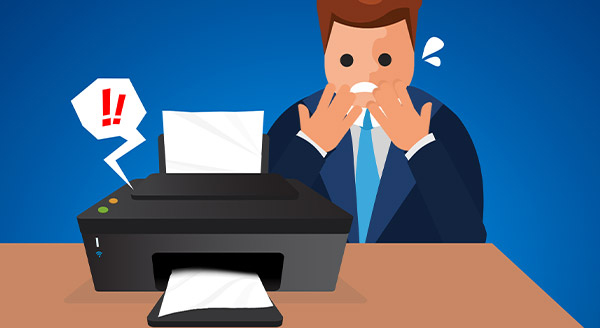
Our phones can recognize our faces. Digital watches can detect that we’ve been in an accident. We can put on a virtual reality headset and feel as if we’re swimming with dolphins. With all this technological innovation, why are printers still so frustrating? This article explains why and how to make the most of the situation.
Hewlett-Packard released its home DeskJet inkjet printer in 1988. These printers spray liquid ink onto the page through printheads. Home laserjet printers followed shortly after. They use lasers to create static electricity to attract and melt toner onto the paper.
And here we are, thirty-five years later, with pretty much the same printer technology. Although now, you might also consider a multifunction (all-in-one) printer. These print documents and can often also scan, copy, fax, and email documents.
But we’re still saddled with clogged inkjets and leaking ink cartridges, plus paper jams, or a printer that can’t recognize the paper that you’ve now taken in and out of the tray 16 times in a row. Why?
Manufacturer Priorities for Printers
Printer manufacturers often lose money selling you the printer. Printer technology is quite complicated, but you’re getting the device for the price of parts. That’s because the manufacturer banks on making their money back on the sale of the ink.
Because they’re looking to make money off ink sales, printer users now endure:
- Ink cartridges that run out quickly – yes, they’re putting less ink in their cartridges these days;
- Printers designed not to work as well if you use off-brand cartridges;
- Having to perform printer maintenance that uses up more ink.
Even if you do invest in top-quality, on-brand ink, you could still encounter problems. Connectivity issues or error messages when you change paper are common.
That’s because the internal workings of the printer can be outsourced to the lowest bidder. Printer longevity is not the goal, so there’s less incentive to develop robust networking components or print drivers.
Plus, Printing is Hard
It’s not all down to printer manufacturer choices. Printing is a complicated process. Many moving parts need fine-tuning to apply the right pressure and position the ink. Plus, people could be using glossy photo paper one minute and recycled paper the next. At the same time, humidity or air that is too dry can also impact the paper and how the printer can move it around.
So, what can you do? Prefer a laser printer, which uses dry powder, if you’re going to print mostly in black and white. You’ll pay more upfront, but you’re no longer hostage to the ink-cartridge dilemma. If you need to do color prints, you might find it’s cheaper to actually go to your local print shop or big-box store.
If your Wi-Fi connectivity conks out, connect the USB cable that shipped with the printer. It may not be as pretty, but it will get the job done.
Want to save hours of your life troubleshooting your printer woes? We can help. Give us a call at 414.456.9837 or contact us to get started.
